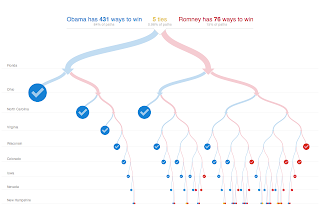Saturday, December 8, 2012
Tuesday, December 4, 2012
Project #13 Collaboration
For my group, Google Docs played a large role in how we communicated before we got together to film our videos.
For Project #15, I made a document with the lesson plan we were going to use and shared it with my partner. From there, she read it over and decided what she liked and didn't like, and we edited things out and put some new things in. As far as meeting up, we emailed each other through our Gmail accounts to establish the best dates for each of us. It helped to be able use Google Docs to collaborate. It cut down a lot of time when meeting because we already had our plan.
While working on Project #16, our contest video, we used Dropbox to gather pictures for the slideshow. We also each compiled a list of reliable sources as far as the facts went that we used. For this, we also used Google Docs. I was able to make a list of sources and share it with my partner. She was able to do the same with me. In my opinion, this helped us so much. We could get all of the "busy work" of our projects done so that when we met up, all we had to do was record our videos.
For Project #15, I made a document with the lesson plan we were going to use and shared it with my partner. From there, she read it over and decided what she liked and didn't like, and we edited things out and put some new things in. As far as meeting up, we emailed each other through our Gmail accounts to establish the best dates for each of us. It helped to be able use Google Docs to collaborate. It cut down a lot of time when meeting because we already had our plan.
While working on Project #16, our contest video, we used Dropbox to gather pictures for the slideshow. We also each compiled a list of reliable sources as far as the facts went that we used. For this, we also used Google Docs. I was able to make a list of sources and share it with my partner. She was able to do the same with me. In my opinion, this helped us so much. We could get all of the "busy work" of our projects done so that when we met up, all we had to do was record our videos.
Sunday, December 2, 2012
C4K November
For November, the first blog I received was that of an 8th grader named Elizabeth. She is in Mr. Boylen's class. The latest blog post Elizabeth had was called "Summer of the Monkeys." She spoke about the subject of the book. According to Elizabeth, the book was hard for her to read because it started off slow. She said that she liked the book because the things that happened in it wouldn't happen in the real world. My comment to Elizabeth expressed how I have a hard time getting into books that start slow as well. With that being said, I told her that usually if you stick with it, they turn out to be really good. I also told her that it seemed like she was reading a fiction novel since the things happening wouldn't happen in reality. My favorite novels are those that are fiction, so I let her know that!
The second blog that I was assigned to was of a girl named Abigail; she writes this blog about World History. In the most recent post, Abigail wrote about the wives of Napoleon Bonaparte post-divorce. Abigail shared that Napoleon hunted for a wife soon after the divorce because he was desperate for an heir. He wanted one woman, but she refused, so he moved on to the archduchess of Austria, Marie Louise. He eventually married her and had a son before being banished to the island of Elba after losing a war with the Allies. In my comment, I let Abigail know that she did a wonderful job on the post. It was very detailed and informative. I also told her that I was a history major and that European History was my favorite. I loved her post, so I told her to keep up the good work!
The second blog that I was assigned to was of a girl named Abigail; she writes this blog about World History. In the most recent post, Abigail wrote about the wives of Napoleon Bonaparte post-divorce. Abigail shared that Napoleon hunted for a wife soon after the divorce because he was desperate for an heir. He wanted one woman, but she refused, so he moved on to the archduchess of Austria, Marie Louise. He eventually married her and had a son before being banished to the island of Elba after losing a war with the Allies. In my comment, I let Abigail know that she did a wonderful job on the post. It was very detailed and informative. I also told her that I was a history major and that European History was my favorite. I loved her post, so I told her to keep up the good work!
Final PLN Report
Since starting my PLN, I have discovered a few more great websites to use on Symbaloo. It helps to have my Symbaloo as my homepage so that I become acclimated to using it. I have separate pages for my personal sites (Facebook, Twitter, etc) and my education sites (Evernote, TeacherTube, etc.) I am happy to have learned about creating my Personal Learning Network. I feel that when working on projects, my PLN comes in handy. It's definitely become a great tool!
Comments for Teachers #4
iLearn Technology: A Blog by Kelly Tenkely
In the first blog post I read of Ms. Tenkely, she wrote about something called 512 Paths to the White House. She found an interactive infographic that showed the different ways candidates could win the presidency. This was found on the New York Times website. Tenkely thought about different ways she could use this in the classroom: students can test out selecting a winner for swing states, explore the infographic as a discovery center, and use it as a class on an interactive whiteboard. In an upper level math course, students could use this to study statistics and probability. There are other features to teach students about the economies of different states, beliefs of each party, and about political advertising.
In my comment, I told Ms. Tenkely that I was an aspiring secondary educator in history. I thanked her for sharing such a great tool. I let her know that I was not invested in politics, but that I could use something like this in my class to get them interested in elections and politics.
The second blog post includes a video that talks about what we are preparing children for. In essence, we are preparing children for "the next step" instead of preparing them to live a meaningful life. Ms. Tenkely's questions: "when are we preparing kids for life? When are we preparing them to engage in the world around them? When are we preparing them for healthy relationships with others? When are we preparing them to ask good questions and seek answers? When are we preparing them for what to do with failure?" These questions are extremely relevant; teachers should teach their subject matter while instilling good values in their students as well. It doesn't matter if you are good at your job, you should still be a great citizen.
My comment to Ms. Tenkely agreed with her 100%. I shared my opinion that we aren't able to teach children how to live because we are too busy teaching them for tests. Teachers are not able to enjoy their career choice anymore because they have no freedom. They have a strict curriculum they have to follow. It takes away the enjoyment of the job. A quote from my comment: "Too many people graduate with bachelor’s degrees that are useless." So true, and so upsetting!
Saturday, December 1, 2012
Blog Post #13
Back to the Future and A Vision of Students Today
In these two videos, technology in today's society is discussed differently. In the first video, Back to the Future, you see that the teacher Brian Crosby teaches his students using a multitude of different types of technology. He shows that you can teach children from any background and bring them together using awesome techniques. Each student in his class is able to use their own laptop. This allows for each child to get the time that they need to learn; they are also allowed to each keep up their own blogs. These blogs talk about what they are learning and to share that with others.
The second video affected me a little more so than the first. Though the first video was quite interesting, the second video, A Vision of Students Today, made me think about my college life. I can agree with most of what was said. I've bought books that I've never used, spent more time on Facebook than doing research, and will be in debt until who knows when.
As an aspiring teacher, I hope that I never have to make my students endure this. I don't want to stick my students in a room and make them bored. I want them to be engaged, so they forget about Facebook. I want to have tools that we use daily and that are interactive, not just dusty books sitting around useless. Students should be submerged in what they are learning, and I want them to enjoy it.
Unfortunately, students in today's education system have to go through this. Classes are boring, and you don't learn anything. You only memorize things for the test and forget them later. Hopefully, I can change that. I want to actively teach and watch my children learn!
In these two videos, technology in today's society is discussed differently. In the first video, Back to the Future, you see that the teacher Brian Crosby teaches his students using a multitude of different types of technology. He shows that you can teach children from any background and bring them together using awesome techniques. Each student in his class is able to use their own laptop. This allows for each child to get the time that they need to learn; they are also allowed to each keep up their own blogs. These blogs talk about what they are learning and to share that with others.
The second video affected me a little more so than the first. Though the first video was quite interesting, the second video, A Vision of Students Today, made me think about my college life. I can agree with most of what was said. I've bought books that I've never used, spent more time on Facebook than doing research, and will be in debt until who knows when.
As an aspiring teacher, I hope that I never have to make my students endure this. I don't want to stick my students in a room and make them bored. I want them to be engaged, so they forget about Facebook. I want to have tools that we use daily and that are interactive, not just dusty books sitting around useless. Students should be submerged in what they are learning, and I want them to enjoy it.
Unfortunately, students in today's education system have to go through this. Classes are boring, and you don't learn anything. You only memorize things for the test and forget them later. Hopefully, I can change that. I want to actively teach and watch my children learn!
Subscribe to:
Posts (Atom)


